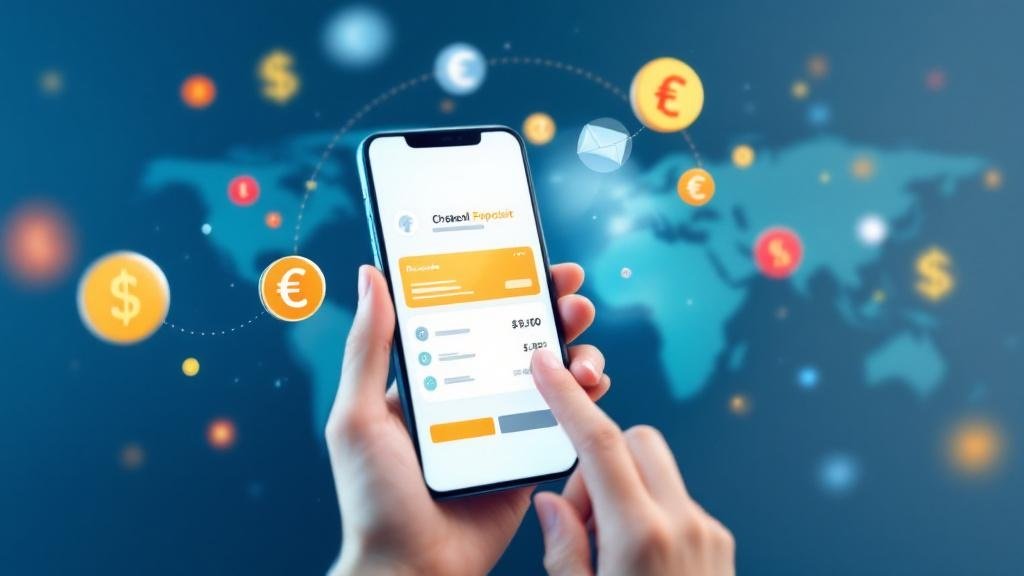With the rise of mobile banking technology, depositing checks no longer requires a trip to the bank or ATM. Thanks to mobile deposit features, you can deposit checks right from your smartphone, saving time and hassle. This guide will walk you through the process of depositing checks using your mobile device, explain the advantages, and explore how mobile banking can transform cross-border payments.
What is Mobile Check Deposit?
Mobile check deposit, also known as remote deposit capture (RDC), allows you to deposit paper checks into your bank account using your smartphone or tablet. Most major banks and credit unions offer this service through their mobile banking apps.
Instead of physically going to a bank or using an ATM, you can simply snap a photo of the front and back of the check using your phone’s camera. Once uploaded, the app processes the deposit and the funds are typically available within a few business days.
Why Use Mobile Check Deposit?
1. Convenience
Mobile check deposit eliminates the need to visit a physical bank or ATM, making it ideal for busy individuals or those living in areas with limited access to banking facilities.
2. Speed
Depositing checks via mobile is often faster than using traditional methods. You can deposit your check at any time, from anywhere, without waiting in line.
3. Accessibility
Many people now rely on smartphones for everyday tasks, and mobile banking apps make it easy for users to perform banking tasks like depositing checks from their phones.
How to Deposit Checks with Your Phone: Step-by-Step
To deposit a check via your mobile banking app, follow these simple steps:
Step 1: Download and Open the Mobile Banking App
First, download your bank’s mobile banking app from the App Store (for iOS) or Google Play Store (for Android). Open the app and log in with your credentials.
Step 2: Select the Mobile Deposit Option
Once you’re logged in, look for an option that says “Deposit” or “Deposit Checks.” The wording may vary depending on the bank, but it’s usually easy to find.
Step 3: Take a Picture of Your Check
The app will prompt you to take a picture of your check. First, place the check on a flat surface with good lighting. Ensure the check is within the frame of the camera screen, and then take a picture of the front of the check.
Afterward, flip the check over and take a photo of the back, where you’ll need to sign your name and include any necessary endorsements (such as “For Deposit Only”).
Step 4: Enter Deposit Amount
After the photos are taken, the app may automatically detect the amount written on the check. Double-check that the app has correctly identified the amount. If not, manually enter the correct deposit amount.
Step 5: Select Your Account
Choose the account where you want the funds deposited. This could be your checking or savings account.
Step 6: Review and Confirm
Before submitting the deposit, review all the details to make sure everything is correct. Once confirmed, hit “Submit,” and your check will be sent for processing.
Step 7: Wait for Confirmation
You will receive a confirmation notification or email once the deposit is successful. The bank will typically process the deposit within a few business days.
Best Practices for Mobile Check Deposits
To ensure your check deposit is processed smoothly, follow these best practices:
Use Good Lighting: Ensure that the check is well-lit to avoid blurry or unclear images.
Keep Your Check Flat: Wrinkles or folds can interfere with the app’s ability to read the check properly.
Verify Your Deposit: Always double-check the deposit details, especially the check amount.
Sign the Back of the Check: Don’t forget to endorse the check with your signature and, if required, write “For Deposit Only.”
Delete the Check After Deposit: Once the check is deposited, destroy it or keep it in a safe place for future reference in case of any issues.
Cross-Border Payments via Mobile Banking
As mobile banking has evolved, it has opened the door to not just local deposits but also global financial transactions. One of the most significant advances in the mobile banking sector is the ability to make cross-border payments from your phone, without the need for traditional banking channels. Let’s explore how mobile payments are revolutionizing cross-border transactions.
1. Mobile Banking for International Transfers
Mobile banking platforms have become a powerful tool for international money transfers. Banks and financial institutions offer mobile apps that allow users to transfer funds across borders, typically at a lower cost than traditional money transfer services. With mobile banking, you can send money to family or businesses abroad in minutes, without having to leave your home.
2. Cross-Border Mobile Payment Solutions
Mobile payment technology allows users to send money across borders using their smartphones. These payment systems are often linked to mobile wallets, which store digital funds that can be used to pay for goods and services or send funds abroad.
Some mobile payment solutions, like PayPal, Venmo, and Revolut, allow international remittance through mobile banking, providing users with a convenient and secure way to send cross-border payments. The mobile payment apps also provide real-time conversion rates and fees upfront, so users can better manage their financial expectations.
3. Global Mobile Payment Systems
Today, global mobile payment systems make it easier for businesses and individuals to conduct transactions in foreign currencies. Services like Google Pay, Apple Pay, and Samsung Pay are integrated into mobile wallets, allowing seamless international purchases or payments across different currencies.
With the increase in cross-border e-commerce payments, these systems are crucial for enabling smooth transactions between buyers and sellers from different countries. As the world becomes more connected, mobile banking apps continue to play a vital role in cross-border commerce.
The Future of Cross-Border Payments via Mobile Banking
The future of mobile banking is bright, especially in the realm of international money transfer apps. Here are a few trends that will shape mobile banking for global payments:
1. Improved Security and Encryption
With the rise in mobile banking transactions, security has become a top priority. Financial institutions are focusing on mobile payment encryption for cross-border transactions to ensure that your personal and financial data are protected. Two-factor authentication (2FA) and biometric verification (like fingerprint or face recognition) are becoming standard features for mobile payment platforms.
2. Instant International Money Transfers
Thanks to advances in payment technology, we are moving toward instant international money transfers. Mobile banking apps that specialize in instant international money transfer provide a fast, hassle-free way to send funds abroad with minimal waiting time.
3. AI and Blockchain Integration
Incorporating artificial intelligence (AI) and blockchain into mobile banking platforms will reduce fraud and streamline cross-border payments. Blockchain technology, in particular, is becoming a powerful tool for cross-border financial transactions via apps, ensuring transparency and efficiency.
4. Wider Acceptance of Digital Payments
As more businesses adopt mobile payment solutions, the accessibility and convenience of mobile payments in foreign currencies will increase. Whether you’re shopping online or paying for a service, you’ll likely find that mobile banking apps will offer more flexible payment options for international transactions.
FAQs on Mobile Banking and Cross-Border Payments
1. How can I deposit a check on my phone?
You can deposit a check using your mobile banking app by taking a photo of the front and back of the check, entering the deposit amount, and submitting it for processing.
2. Is mobile banking secure for international payments?
Yes, mobile banking is secure for international payments, provided the app uses encryption and security measures like two-factor authentication. Always ensure you’re using a trusted mobile banking app.
3. Can I send money internationally using my mobile banking app?
Yes, many mobile banking apps allow you to send money internationally. Services like PayPal, Venmo, and Revolut make it easy to send cross-border payments from your phone.
4. What are the fees for cross-border payments via mobile banking?
Fees for cross-border payments via mobile banking depend on the app or service you use. Some apps offer low fees or no fees for small transfers, while others may charge a percentage of the total transfer amount.
5. How do mobile payment systems handle foreign currency exchanges?
Mobile payment systems typically provide real-time currency conversion, allowing you to send money or make payments in foreign currencies at competitive exchange rates.
6. What are the best apps for cross-border payments?
Some of the best apps for cross-border payments include PayPal, TransferWise (now Wise), Revolut, and Western Union. These apps allow for fast, secure, and cost-effective international transfers.
7. How long do mobile check deposits take to clear?
Most mobile check deposits take 1-2 business days to clear, although some banks offer faster processing for certain types of checks.








Comments (0)